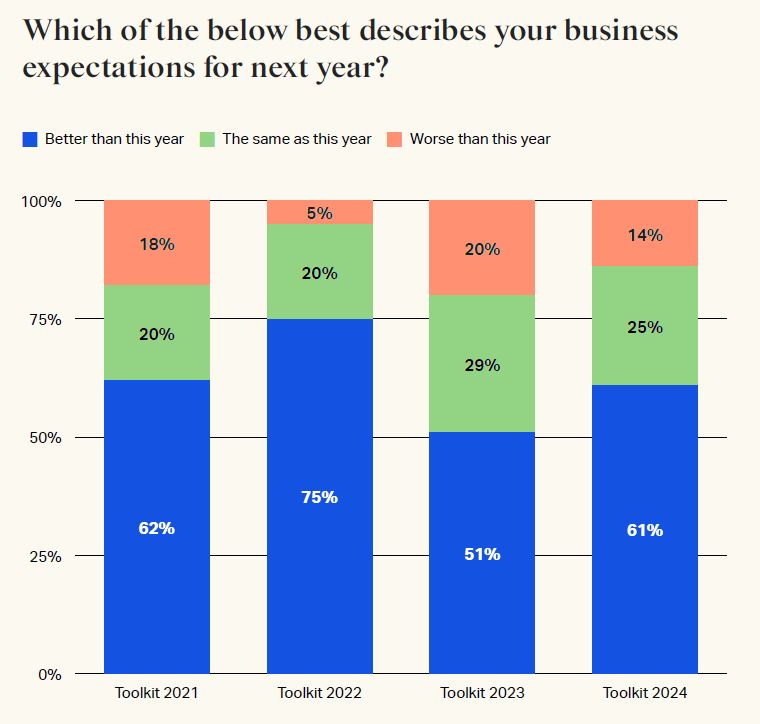Aditya Kishore, Insight Director at WARC and principal author of the Makreter’s Toolkit 2024 introduces the biggest issues facing marketing in an economy that has threatened recession but has turned out to be more confident than most had realised - looking to the year ahead, these are the big issues.
Here’s the thing about 2024. At a macro level it looks tough. But compared with 2023, most marketers see growth opportunities for the year ahead.
This is born out by the research for the Marketer’s Toolkit 2024: WARC members can read the full report right here. If you’re not yet a member, you can find a sample of the report here.
The economic outlook is at best mixed. While supply chains have adapted to the Ukraine war and inflation appears to be subsiding, sanctions continue to affect the global economy. We also face a slowdown in the Chinese economy and a fresh crisis in the Middle East.
The IMF is forecasting that global growth will slow to 2.9 percent in 2024, the lowest in decades. Global inflation is forecast to decline from 6.9% in 2023 to 5.8% in 2024, but won’t return to target until 2025 in most cases.
Yet consumer spending remains surprisingly high, especially in sectors such as travel. It has kept the US economy out of recession, and helped coin the term “YOLO economy”: an economy driven by consumers prioritising today over the future.
Marketers globally are certainly concerned about the economic picture. It is the biggest factor in 2024 planning, with 64% of marketers in the Marketer’s Toolkit survey seeing it as having a significant impact. Similarly, inflation and the cost of living are named as the top ‘cause for concern’.
But as consumers keep spending, confidence appears higher than 12 months ago, with a clear majority of firms expecting improved business performance next year.
That should translate into ad dollars. Thanks to events such as the Olympics and election spending, WARC expects global adspend to grow 8.2% in 2024, topping $1 trillion for the first time.
So what explains this confidence?
To some degree, marketers have grown accustomed to uncertainty – scenario planning has become de rigueur.
And a period of economic volatility may have strengthened the case for marketing. Analyst Ian Whittaker, Managing Director of Liberty Sky Advisors, recently pointed out that the inflation of the past year has been “a vast, unplanned experiment in showing how… brand marketing provides true financial value to companies”. His evidence – the string of big-name packaged-goods companies posting bumper revenues, having implemented price rises without tanking volume.
Equally important, a time of change for consumers has offered some CMOs the chance to double down as the eyes and ears for the business. In times of uncertainty, consumer insight becomes even more critical. Forrester research has found that businesses with advanced insights-driven capabilities are eight times more likely to say they grew by 20% or more.
And that’s where the Marketer’s Toolkit comes in. This document, built on WARC’s GEISTE methodology, runs through some of the emerging threats and opportunities marketers will face as they look for sources of growth.
Yes, that includes Generative AI, which will continue to dominate the tech agenda in 2024. And, as elections in the US loom, the challenge of marketing to an increasingly polarised consumer base – whither progressive ‘brand activism’ post-Bud Light?
In an Olympic year, we also cover the growing importance of sport as a way to bridge those divides – and the need for reputational care as what some would see as sportswashing dollars join the party.
Our other two trends are vast. Sustainability and the unfolding climate crisis are now a mainstream topic of discussion; companies are responding by focusing on acts, not ads. For marketers, that means less communication about sustainability credentials, and more behind-the-scenes work, including a focus on community oriented initiatives.
Finally, the alarming numbers of “deaths of despair” amongst young men is focusing attention on male stereotypes and the cultural expectations created by media and advertising.
We hope you find the report useful.


